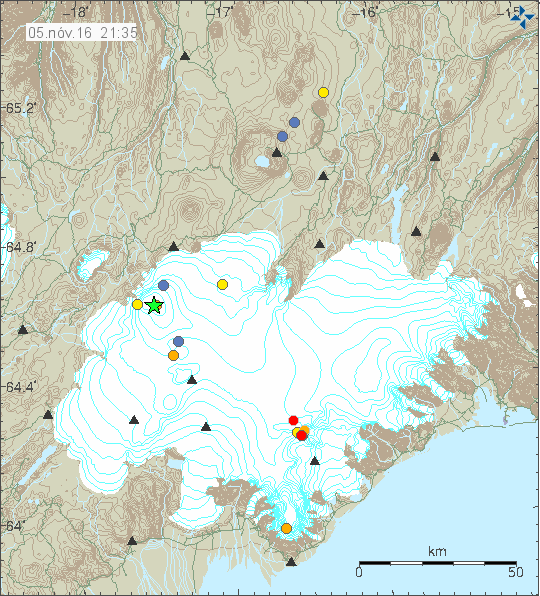For the few hours (on 05-November-2016) there has been a minor earthquake activity in Esjufjöll volcano [Wikipedia information]. Esjufjöll volcano is not a volcano that gets a lot of attention because most of the time its completely quiet, with last notable activity taking place in the year 2013. Earthquake activity started to appear in Esjufjöll volcano in the year 2002 (IMO map here and here).

Earthquake activity in Esjufjöll volcano (north east of Öræfajökull and south of Grímsvötn volcanoes). Copyright of this image belongs to Icelandic Met Office.
At the moment not many earthquakes have taken place in Esjufjöll volcano. That might maybe change, but I don’t expect it to. Maximum number of earthquakes recorded so far (in 2002 at least) is around 40 – 80 (I’m not sure to the exact number). The reason why Esjufjöll volcano is having earthquake activity is due to fresh magma pushing up the volcano from deep inside it. At the moment there isn’t anything suggesting that an eruption is about to happen and if an eruption does happen I would not expect it to be big. The chance of an eruption taking place in Eskjufjöll volcano is around ~2% at the moment in my view.
The only eruption that might have happened took place in the year 1927, at the moment it has not been confirmed. It may have only been active for around 4 days at maximum and took place on September 5. The information is not that good due to how remote this volcano is (map can be found here, Esjufjöll are located south of Grímsvötn, north-east of Öræfajökull volcano).
Donations
Please remember to support my work. In November I’m rather broke due to many and high bills that I had to pay this month. Thanks for the support. 🙂

Great, thanks Jón!
Thank you.
Great work once again Jon.
Yes, I concur great work!
I just wondered if someone more knowledgeable than me could comment on how common it is to have the conductivity within Múlakvísl raised to over 150 for a few weeks (often higher than this and over 190 at the moment). My questions are:
Has this sort of prolonged raise happened often?
Is this considered to be a likely prelude to an eruptive phase based upon past levels?
I suspect that new hydrothermal vents have opened up in Katla volcano under the glacier that explains this high conductivity. The weather in Iceland at the moment is also really warm given the time of the year. Up to 17C at the moment in some areas.
Great work Jon!
I also have a question, Wikipedia refers to Esjufjöll as having the following:
” consists of the Snaehetta central volcano and a large caldera”
What is Snaehetta ? Is that the name of the main vent or something else I could not find an english translation for Snaehetta.
Snæhetta is a ridge in the Esjufjöll volcano system. Its a high peak that stands up in the glacier. I found this pdf file with a map on (page 2).
http://hfsu.is/wp-content/uploads/2015/02/snaevarr.pdf
I am no expert but I would translate snæhetta as snow hood or snow cap.
Only five earthquakes so far in Iceland today (8-November-2016) and I’m broke (and its quite bad).
A little donation is on the way!
Thanks for your work.
Thanks for the support. It helps me a lot. 🙂
conductivity in Múlakvísl back up to 190 even after heavy rainfall last night, why is the conductivity so high at this time of year?, is this an indication that she is preparing for an eruption in the next couple of months? I would sure like to know
This seems to indicate that new hydrothermal systems have opened up under the glacier and are now melting water. Increased geothermal heat in a volcano can be a sign that it is preparing for an eruption. Such thing happened in Askja volcano before it blew it self up in the 19th century.
Dear Jon, I found your description of the 1875 Plinian eruption of Askja amusing.
Do you find Jon’s wording amusing or his way of recounting the history of this event amusing? I am not sure the farmers on those farms were amused?
Friday
11.11.2016 17:20:03 64.622 -17.391 0.1 km 3.5 99.0 6.8 km ESE of Bárðarbunga